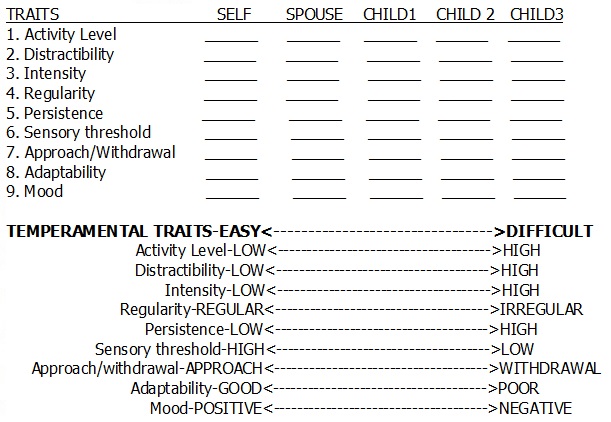Temperamental Evaluations - RonaldMah
Ronald Mah, M.A., Ph.D.

Licensed Marriage & Family Therapist,
Consultant/Trainer/Author
Main menu:
Temperamental Evaluations
for Parents & Educators > Handouts > Understanding Ch Beh Handouts

"What is with This Kid!?"


DIAGNOSTIC ORDER FOR APPROACHING CONFLICTUAL BEHAVIOR
1) Developmental factors (including life cycle issues for adults)
CAUSE: development, age, maturationTREATMENT: satiation of developmental needsIMPLICATIONS/JUDGEMENTS: person is reacting normally to normal developmentTOLERANCE: high (if developmental stage is recognized)
2) Situational factors (other children/colleagues, availability of toys/resources)
CAUSE: situationTREATMENT: change the situationIMPLICATIONS/JUDGMENTS: person is reacting normally to the immediate situation only; the behavior is not something he/she does all the timeTOLERANCE: high
3) Physical condition
CAUSE: fatigue, hungerTREATMENT: treat condition- rest or feedIMPLICATIONS/JUDGMENTS: person is reacting normally to the condition; condition changes, then behavior changesTOLERANCE: high
4) Emotional condition (situational)
CAUSE: fear, anxiety, joy, sadness, griefTREATMENT: validate emotions, teach appropriate expressionIMPLICATIONS/JUDGMENTS: person is reacting normally; colleague or supervisor may have judgment about appropriateness of the feelingTOLERANCE: high (depends on own comfort w/expression of emotions)
*5)Temperamental factors
CAUSE: personalityTREATMENT: adjust for temperament/ socializeIMPLICATIONS/JUDGMENTS: person is reacting based on innate normal traits for him/herTOLERANCE: *high for temperament, *low for behavior
*6) Environmental/ecological factors (family, school, work systems)
CAUSE: family/school systems, turmoil, constraints- dysfunctionalityTREATMENT: alter system, change environmentIMPLICATIONS/JUDGMENTS: person is reacting normally to an adverse environment; victim of the environmentTOLERANCE: high- sympathetic (colleague/supervisor may have guilt)
*7) Pathology (psychological)
CAUSE: person's psychological problem/disorderTREATMENT: treat problem/disorder- "sick" patientIMPLICATIONS/JUDGMENTS: something is wrong with the personTOLERANCE: low to high?
**8) Morality
CAUSE: evil or rotten essenceTREATMENT: abandonment, punishment, damnation, or seeking of spiritual interventionIMPLICATIONS/JUDGMENTS: person is unsalvageable by another's activity or interventionTOLERANCE: none to ?
TEMPERAMENTAL TRAITS
1. Activity Level: How active generally is the child/person from an early age?
2. Distractibility: How easily is the child/person distracted? Can s/he pay attention?
3. Intensity: How loud is the child/person generally, whether happy or unhappy?
4. Regularity: How predictable is the child/person in his/her patterns of sleep, appetite, bowel habits?
5. Persistence: Does the child/person stay with something s/he likes? How persistent or stubborn is s/he when wants something?
6. Sensory threshold: How does the child/person react to sensory stimuli: noise, bright lights, colors, smells, pain, warm weather, tastes, the texture and feel of clothes? Is s/he easily bothered? Is s/he easily over-stimulated?
7. Approach/withdrawal: What is the child/person's initial response to newness- new places, people, foods, clothes?
8. Adaptability: How does the child/person deal with transition and change?
9. Mood: What is the child/person's basic mood? Do positive or negative reactions predominate?
*Important to note that high or low in any trait is not implicitly good or bad.
TEMPERAMENTAL EVALUATION & GOODNESS OF FIT EVALUATION

FIVE ELEMENT PROGRAM
1) EVALUATION- defining the problem, study your child, family reactions.
- 2) REGAINING ADULT AUTHORITY- think temperament and to deal with behavior instead of responding emotionally or instinctively to what you perceive as the child's motives. Learn to:
- disengage, to become neutral in attitude, to think and evaluate before responding, to understand behavior as it is related to temperament, to replace why is he doing this to me w/ how can I understand his behavior.
- 3) MANAGEMENT TECHNIQUES- management is different from discipline. Labeling, cooling off, sense of timing, dealing with change, eye contact, choices, introducing gradually, understanding manipulative versus temperamental tantrums. Engage in self-monitoring and understanding your child.
- 4) FAMILY GUIDANCE
- 5) SUPPORT GROUPS
Book recommendation: The Difficult Child, Stanley Turecki, M.D., Bantam Books, New York, 1989. $9.95 in paperback.
QUICK CHECK FOR LEARNING STYLE
- When you get a new gadget or new game, what is your instinctual reaction?
a) start playing around w/it,b) read the instructions,c) have someone tell you how to do it.
- To learn how to get to somewhere new, what is your preference?
a) have someone take/show you,b) look at a map,c) have someone verbally give you instructions.
- In a classroom or seminar situation what format do you prefer?
a) discussion,b) visual aids,c) lecture.
MOTOR-KINESTHETIC LEARNERS tend to favor answers (a).
VISUAL LEARNERS tend to favor answers (b).
AUDITORY LEARNERS tend to favor answers (c).
If you favor a combination of these choices or if it is hard for you to chose one over another, then you probably have strengths in more than one learning style.
Auditory (listening)
Strengths:
Spelling, Phonics, Vocabulary, Ten Verbal Excuses, Talks a lot, Reads out loud well.
Weaknesses:
Poor Reading, Poor Following Directions, Can't Hear Differences between sounds, Says "gizmo", "whosit", Poor comprehension.
Visual (seeing)
Strengths:
Enjoys books w/ pictures, Recalls location of objects, Comments on clothing, Puzzles, Drawings, Notice/comment on visual detail.
Weaknesses:
Short attention for paper/pencil tasks, Poor printing, Poor visual memory, Poor spacing when writing, Skip words when reading aloud.
Motor Kinesthetic (movement, touch)
Strengths:
Bear hugs, Thump buddies on back, Loves climbing-never spills, Touch everything, Makes airplanes & fans from paper, Loves clay, sandbox.
Weaknesses:
Illegible handwriting, Dislikes drawing, Awkward, clumsy, Poor speech, Lacks interests other than TV, Exhibit body tension.
------------------------------
Many of the children who can't sit still, are always touching things, and tantruming that you have difficulty with in the classroom or at home have strong motor-kinesthetic tendencies. Traditional classroom teaching is largely visually oriented. Most teachers are visual learners, and thus, visual teachers.
As you recognize the learning style of each child, you can teach to that style; and you can help the child learn how to compensate for learning style weaknesses. Examples are
Auditory learners and knowing the time;
Motor-kinesthetic learners and touching inappropriately or violating personal space;
Visual learners and short pen-pencil attention span.
Creating ways for and allowing the high energy, moving, touching motor-kinesthetic child to satisfy these needs prevents the frustration of being unable or not being allowed to met these needs in a strongly visually or auditorially oriented program. And, once these needs are satisfied, the motor kinesthetic child is better able to attend, to sit quietly, to not touch and so forth. In other words, what is seen as "giving in" to the child is really a means to bring him/her into the group.

